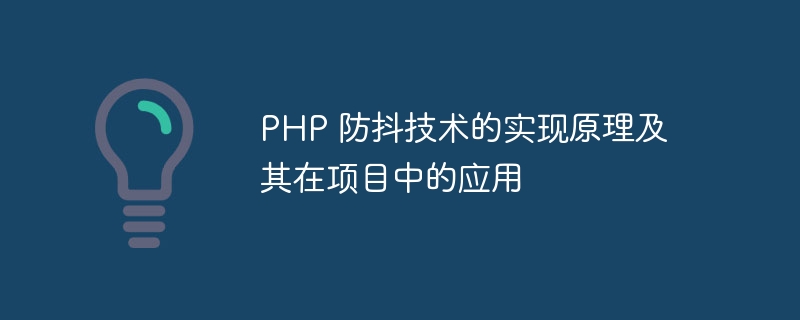

The implementation principle of PHP anti-shake technology and its application in projects
Anti-shake technology (Debounce) is a technology commonly used in front-end development. After an event is triggered, the corresponding operation is delayed until the event stops triggering for a certain period of time before it is actually executed. This technology is often used to reduce the performance impact of frequently triggered events and improve user experience. Anti-shake technology can also be implemented in PHP to handle certain frequently triggered operations, such as real-time queries in the search box.
Implementation principle:
The principle of implementing anti-shake technology in PHP is similar to that of the front end. By setting a timer, wait for a certain period of time after the event is triggered before performing the corresponding operation. If the event is triggered again during the waiting time, the timer is reset and timing is restarted until the event stops triggering and the corresponding operation is performed after the waiting time is reached.
Below we use a specific example to illustrate the implementation of anti-shake technology in PHP.
class Debounce
{
private $timer;
private $delay;
public function __construct($delay = 500)
{
$this->delay = $delay;
}
public function debounce($callback)
{
if ($this->timer) {
clearTimeout($this->timer);
}
$this->timer = setTimeout($callback, $this->delay);
}
}
// 示例使用
$searchFunction = function() {
// 执行搜索操作
}
$debounce = new Debounce();
$debounce->debounce($searchFunction);In the above example, we created a Debounce class, and the constructor receives a delay time parameter, which defaults to 500 milliseconds. The debounce method in the class is used to perform anti-shake operations, passing in a callback function as a parameter. In the debounce method, we first determine whether a timer exists. If it exists, clear the previous timer, and then reset a new timer with the delay time being the set delay time. Through such operation, the anti-shake effect can be achieved.
Application in actual projects:
In actual projects, anti-shake technology is suitable for some operations that require frequent triggering, such as real-time queries in the search box. When users enter content in the search box, if each input triggers a search operation immediately, a large number of requests will be sent to the backend, increasing the pressure on the server, and making the web page unsmooth. This problem can be avoided by using anti-shake technology, which only triggers the actual search operation after the user stops typing for a period of time.
The following is an example of using anti-shake technology in a PHP project:
function search($keyword)
{
// 执行搜索操作
}
if (isset($_GET['keyword'])) {
$keyword = $_GET['keyword'];
// 创建一个防抖实例,设置延迟时间为 1000 毫秒
$debounce = new Debounce(1000);
// 将搜索函数作为回调函数传入防抖实例
$debounce->debounce(function() use ($keyword) {
search($keyword);
});
}In the above example, when the user enters content in the search box, the entered key will be sent through a GET request. Words are passed to the backend script. In the back-end script, we create an anti-shake instance and set the delay time to 1000 milliseconds. Then pass the search function as a callback function into the debounce method of the anti-shake instance. In this way, when the user inputs, the search operation is actually triggered only after 1000 milliseconds of stopping input, effectively reducing the frequency of requests.
Summary:
The implementation principle of anti-shake technology in PHP is similar to that of the front end. By setting a timer to delay execution of operations, performance problems caused by frequent triggering events can be effectively reduced. In actual projects, anti-shake technology is suitable for some operations that require frequent triggering, such as real-time queries in the search box. By using anti-shake technology, the user experience can be improved and the pressure on the server can be reduced. In PHP, we can implement anti-shake operations by creating an anti-shake class and perform corresponding operations through callback functions.
The above is the detailed content of The implementation principle of PHP anti-shake technology and its application in projects. For more information, please follow other related articles on the PHP Chinese website!




